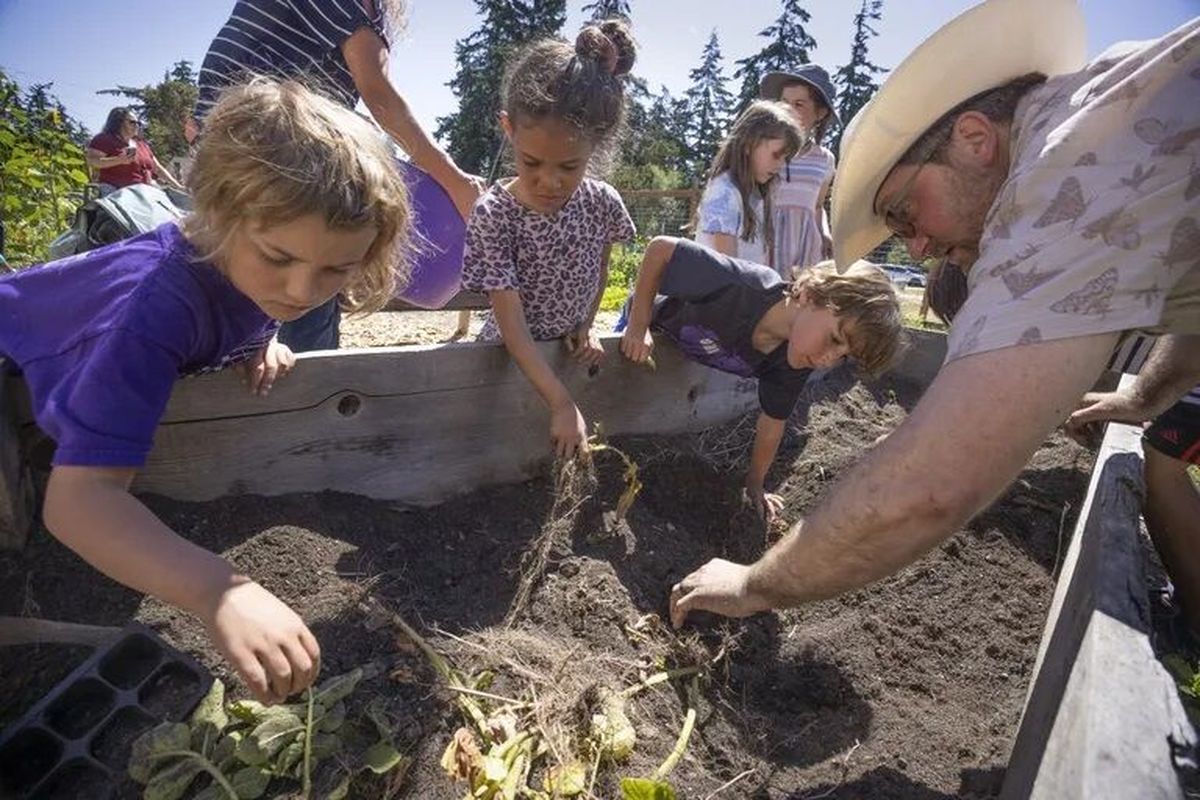Port Townsend district uses produce from its garden for school meals
Second-graders Bea Favicchio, left, Esmee Stewart and Darrian Morris learn how to harvest potatoes from farmer Neil Howe at the Salish Coast Elementary Garden on July 16 in Port Townsend. (Ellen M. Banner/Seattle Times)
PORT TOWNSEND – A group of first -graders plucked snap peas from the vines and deposited them into the colorful buckets near their feet.
Some sank their teeth into the seeds, while others, who were farther away, stuffed the vegetables into their back pockets for safekeeping.
“The key is going up high,” one student advised his classmates. “Reach as high as you can. I got a couple of good ones by going up high.”
As they heeded this advice, another student gave his opinion on the harvest so far: “They taste like sugar.”
The kids were at the Port Townsend School District’s production garden, a 12,000-square-foot verdant plot near the Salish Coast Elementary School parking lot, on a recent Tuesday morning. They were picking peas, digging up potatoes and jockeying for good spots to watch – and help – Neil Howe, the farm production manager, turn on a potato washer to remove dirt from the potatoes they had harvested.
Last year, the garden produced about 4,000 pounds of fruits and vegetables for the district’s cafeteria. That bounty included kale, celery, potatoes, tomatoes, peppers, cabbages, cucumbers, lettuce, broccoli, basil, Italian bush beans, summer squash, strawberries and bunching onions.
The day before, community volunteers had hauled in 35 pounds of basil that the district’s cafeteria staff will turn into pesto for pizza and pasta dishes during the school year. Two weeks before that, it was peas.
“It can be overwhelming when you are picking for 12 to 20 hours a week,” said Howe, who puts in about 30 hours a week in the garden.
“Ours are so prolific,” he added of the district’s pea plants. “Everybody in town has asked me about it.”
The number of Washington districts participating in the U.S. Department of Agriculture’s Farm to School program has been increasing in recent years. In 2019, 68% of school food service departments that responded to a USDA survey said they participated in the initiative. About half were new to the program in the last three years, while 9% had been involved for more than 10 years. Just more than a third had school gardens.
Even so, the Port Townsend program “is not typical of what you’d see in most schools with garden programs,” said Annette Slonim, the Farm to School lead at the Washington State Department of Agriculture. First, the district offers a teaching garden at every school, not just the elementaries. And while other school systems have production gardens, most don’t send the majority of the food grown to the school cafeterias, Slonim said.
“It’s very exciting and fantastic where those programs exist,” she said.
Port Townsend’s farm program is part of the district’s place-based learning philosophy that ties learning to the community. There’s a teaching garden at the elementary school, with scarlet runner beans and variegated lettuce and potatoes, and also sunflowers and marigolds and lamb’s ears. Students at Blue Heron Middle School grow apples, figs and pears in an orchard. Those at Port Townsend High School tend to strawberries and rows and rows of corn, broccoli and squash.
The teaching-garden initiative goes back about two decades, while the production garden, which supplies about half of the vegetables used in the cafeterias, opened only last year.
“We encourage them to ask questions, research answers and come up with solutions that make our community better,” said Linda Rosenbury, the superintendent who moved from New York to Port Townsend because of the program. “We think that when we engage students in exploring the world around them they are more excited to learn.”
How students use the gardens varies by grade. First -graders, for example, engage in activities that allow them to use their five senses. They also learn about the different parts of the plants, harvest seeds, plant and participate in art projects, such as leaf etchings. Second -graders learn about pollination and common bugs found in gardens – predators (ladybugs), pollinators (bees) and pests (aphids) – and about “three sisters” beds, an Indigenous way of growing corn, beans and squash.
Third -graders dig into seed dispersal and pollination, while fourth- and fifth -graders explore the food web, photosynthesis and composting, said Isabel DuBois, the elementary school garden teacher.
At the middle school, there are lessons on grafting, and students graft an apple tree that they take home at the end of the school year, said Sarah Rubenstein, the district’s place-based learning director.
High school students plant and harvest the fruits and vegetables. Those in health and culinary arts classes make kale chips and smoothies and learn the basics of preparing healthful meals, Rubenstein said. Students use the corn they grow to make tortillas in their Spanish class. The high school garden also provides produce for the local food bank.
“A lot of students get excited about eating kale fresh from the garden, or eating broccoli fresh from the garden,” Rubenstein said. “When they taste the fresh vegetables they picked themselves, they have a positive experience with it. It has a lot more flavor.”
Sean Moss, the high school principal who worked at the middle school last year, said the gardens also offer benefits to students’ emotional well-being. The orchard had a calming effect on his middle school students and was a “wonderful” respite for children who felt overwhelmed at recess and needed some quiet time. Teachers also used it in lieu of detention. Instead of sending a child to a classroom or detention during lunch, teachers would sometimes take the child for a stroll through the grove.
“We’d pick a pear, or fig or an apple,” Moss said. “It really worked well. Students – at that age, especially – it’s important to give them a chance to reflect.”
Shannon Gray, Port Townsend’s food service director, said students are more likely to eat from the salad bar when they know that the vegetables came from outside their windows. The district has also started handing out sweet peppers and small cucumbers in little bags instead of Goldfish crackers and packaged snacks.
“I have signs that go on our salad bar here, and if I forget the sign that says it’s from our garden, they kind of pick at it,” Gray said. “But once I put that sign up … they are all over it.”
Gray has been a big part of the district’s success in adding fresh and locally grown food to the menu. She started in 2006, a mother of four children, with no professional cooking experience. A dishwasher at first, she rose to become a baker and then a cook by the time the district switched to scratch cooking in 2014. She took over as lead chef in 2015 when the then-head chef left.
Menu offerings now range from stir-fries to chickpea curries. There are also meatless Mondays.
“We have been doing this for so long, we say we’re creating foodies,” Gray said. “This is how they choose to eat, even at home.”
Rosenbury, the superintendent, said community commitment, both financial and otherwise, is a key to making a program like this work. The district included the production garden in a $40 million bond it floated in 2016 for Salish Coast Elementary School. Capital levies and federal and state grants, including from the USDA and the state Department of Agriculture, have also helped. Dozens of volunteers regularly donate their time to harvest the crops, and a new greenhouse is underwritten, in part, by the local Rotary Club.
Despite the benefits, it costs about $100,000 more to run Port Townsend’s locally grown food program than a traditional one. Gray said that’s primarily because “it’s cheaper to buy a bunch of carrots in a plastic-sealed bag.”
Teachers must be willing to adapt lessons and the kitchen staff has to be ready to make the jump to scratch cooking, which can be a difficult transition, Rosenbury and Gray said.
Having a collaborative team that not only listens, but is also capable of making concessions, goes a long way. The district’s garden committee, which oversees the program, includes a cross-section of the community, including principals, teachers, food service staff and volunteers. (It helps that Gray, the food service director, is married to Justin Gray, the maintenance and facilities director, Rosenbury said, jokingly. They’re one of two couples involved in the program. Howe and Bonnie Obremski, the substitute farm manager and a volunteer, got married recently.)
Still, there were roadblocks. Supply chain shortages and labor issues during the pandemic stalled the construction of the fence around the plot. The cement for the greenhouse was also delayed.
On a recent weekday in July, the food service staff served tacos to students in the summer program. The beef came from local farms, and the cucumbers, snap peas and cauliflower in the salad bar were all district grown. The applesauce came from apples grown in the middle school garden.
Rosie Dunham, 8, who is heading into third grade next school year, said it was “amazing” that she got to eat the food she had a hand in cultivating.
“I like the cucumbers, the apple sauce, the carrots, the fruits,” Rose said.
“I know where it comes from,” she added. “You get to plant the food, harvest the food, and then you get to eat it.”
Holland Mangold, 10, balanced his plate on his knees as he sat with a group of friends.
“I really, really like the strawberries,” said Holland, who will start fifth grade in the fall. The staff serves fresh strawberries when they are in season. Staff members also freeze-dry some and serve them as snacks or sprinkle them on desserts.
Holland is a fan of the gardens and listed making apple cider and planting peas as some of his favorite garden-related activities.
“I think it’s pretty cool,” he said. “If we never had a garden here, it would be harder to have these.”
Holland’s mother, Candace Mangold, was in the district’s PTA leadership – first as vice president and then as president – when Port Townsend started raising money to go all in on farming.
“I know my kids are super appreciative of the culinary staff and the servers at lunchtime,” Mangold said. “They are always very pleased with the food. I hear very little complaints.”
Moss, the high school principal, appreciates the focus on locally grown food as an educator, parent and consumer. He recalled how surprised he was when his son came home one day raving about the minestrone soup he’d had at lunch.
“It took me aback,” Moss said. “I remember eating cheeseburgers, fries and Tater Tots (in school). For him to come home and talk about nutritious food in such a positive manner – it made me really happy as a parent that my son is in the district.”
He also thinks the program does a lot more for kids than teach them to like minestrone soup and strawberries.
“Oftentimes we think about school and what it can teach kids to get them employment as adults,” Moss said. “But there’s a lot of importance with public education to ensure that students become holistic adults. I think the purpose of programs like these aren’t necessarily to create a plethora of professional farmers, but rather to give all students an appreciation for healthy foods and the importance at an early age of that.”

